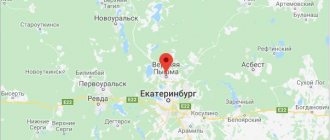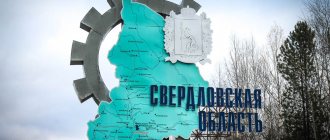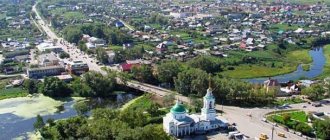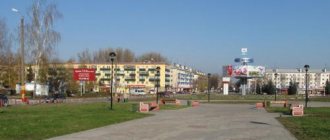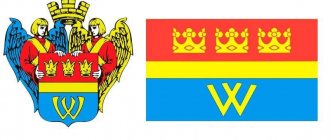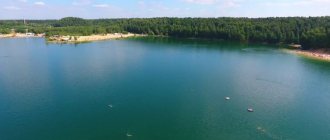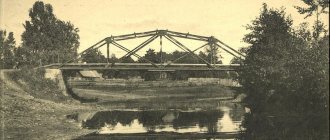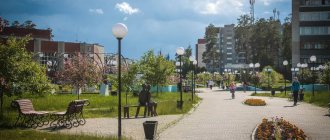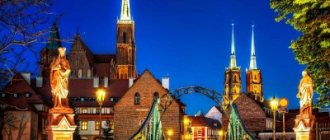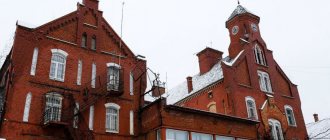Sysert: TOP-3 places to see in 1 day
When staying in Sysert for one day, tourists should pay attention to the best attractions of this city.
Mount Bessonova
- Coordinates on the map: 56.486602, 60.812363.
Mount Bessonova is located on the territory of Sysert and has long been considered the main symbol of the city. There are two versions about the origin of its name:
- The first is associated with the uprising of Emelyan Pugachev. In 1774, when the Pugachevites stormed the mountain, tsarist troops came out to meet them. One of those killed in this battle was Sergeant Bessonov.
- According to the second version, the name comes from the word “demon”. According to some historians, a pagan temple of the first settlers of the Sysert land could have been located on the slope of the mountain.
In 2001, a cast-iron Orthodox cross, donated to the city by Uralhydromash, was installed on the top of the mountain. The height of the cross reaches 12 meters, thanks to which it can be seen from anywhere in the city. The gift was made in honor of the 270th anniversary of Sysert.
Mount Bessonova is a popular holiday destination for citizens and tourists. The peak of popularity occurs in winter, when a ski slope opens on one of the slopes.
House-Museum of Pavel Petrovich Bazhov
- Address: st. Volodarsky, 16.
In 1879, the future writer Pavel Bazhov was born in Sysert. His parents were simple working people, so his childhood was spent in a modest environment. He spent a lot of time with peasants who told him stories from their lives and ancient legends. Subsequently, they were reflected in the book “Malachite Box”.
A museum dedicated to his memory is located in his homestead. This is a cozy log cabin with beautiful trim and fine carvings on the cornices and gables. The museum was founded in 1967. The peculiarity of the estate is that all its furnishings remained untouched, as if Bazhov had never left it.
The house has four rooms, each of which represents a separate exhibition. Here you can see furniture from the Bazhov family, kitchen utensils from the 19th century and other household items. The main hall of the museum is a study in which Pavel Petrovich wrote such stories as “The Green Filly” and “Far and Near.” Another attraction of the museum is the garden, in which the linden trees planted by Bazhov have been preserved.
Natural Park "Bazhovskie Places"
- Address: st. Timiryazeva, 68A.
The park was created in 2007 and immediately received the status of a specially protected area. It did not get its name by chance. It was these places that inspired the writer, many of them are described in his works. The natural area occupies more than 40 thousand hectares. This territory contains unique creations of nature, for example, the ancient Chernovsky Canal, the Beryozovy Uval ridge and the crystal mines.
Tourists are most attracted to Lake Talkov Kamen. It was formed in the 19th century in an abandoned talc mine. The lake has a high mineral content and a variety of underwater vegetation. The inhabitants of the lake include water striders and water scorpions.
The lake is not only a tourist site, but also a place for training divers. According to them, a wooden support was preserved at the bottom of the mine. The permissible immersion depth is six meters. Then the tree debris begins.
The second interesting object is Mount Markov Stone. It is an element of the Kaslinsko-Sysertsky ridge. There is a legend among tourists that an ancient altar was found at the foot of the mountain.
Markov stone is completely covered with coniferous trees. At the top there is a wooden gazebo and an observation deck. It is not recommended to go up to them, since both structures are quite dilapidated.
“Bazhov places” are regularly visited by tourist groups. Excursions take place along developed routes. Most often, tourists travel on foot to Lake Talkov Kamen and Markov Kamen. There are also trails for ATVs, snowmobiles, paddleboards and kayaks.
Folk Museum
There is a museum in one of the premises of the plant. Some of the exhibits were found right here - during the clearing of the territory. Everything can be touched and rotated - complete interactivity and immersion of the viewer into the space.
Money for the museum was collected through crowdfunding - people transferred the required 400 thousand rubles in 2 months. This was enough to create the first exhibition, but the creators have grandiose plans. In the large adjacent room of the plant, they want to recreate an open-hearth furnace in augmented reality to make it easier for visitors to imagine the plant’s industrial past. In the meantime, there is a temporary storage area for lost and found items.
Cultural recreation in Sysert
The culture of Sysert rests on three “elephants”: museums, theaters and beautiful places for walking.
Palace of Culture named after I.P. Romanenko
- Address: st. Lenina, 32.
The cultural program of the Palace of Culture is very diverse. It hosts performances by a local theater group based on classic works and original scripts that will appeal to both children and adults. There is a children's breakdancing school at the Palace of Culture.
Incendiary concerts of little dancers give visitors an incredible experience. In addition, the Palace of Culture hosts annual photography competitions on various topics and the “Little Miss” competition, as well as professional holidays, educational and military-patriotic events.
Museum of Local Lore
- Address: st. Bykova, 56.
The Sysert Local History Museum was founded in 1969. It occupies a building that in itself is of historical value - this is the Main Office of the Sysert District, built in 1779 on the initiative of A.F. Turchaninova. This is evidenced by a memorial plaque on the façade of the building.
The museum's slogan: “You cannot recognize the world without knowing your land.” These are the words of Pavel Petrovich Bazhov. Initially, the museum's exhibition consisted of ancient objects donated by city residents. Over the years, thanks to numerous archaeological campaigns and donations from museums in other cities, the exhibition has become more extensive and interesting.
Currently, museum visitors have the opportunity to trace the history of the Sysert district, from antiquity to modern times. During the excursion, tourists will see a collection of musical instruments dating back to 1903; cannons cast at a local factory during the Patriotic War of 1812; items of peasant and noble use, a mineralogical collection, as well as ancient photographs and documents.
Of no less interest are temporary exhibitions dedicated to historical events, indigenous culture and social problems of our time. The museum regularly hosts cultural and educational events, including creative competitions, lectures, literary talks, and screenings of documentaries.
Sysert porcelain
- Address: st. Chapaeva, 1.
On Chapaya Street there is one of the many porcelain shops. Sysert porcelain has long been famous for its high quality and beauty. This artistic craft began with the home production of ceramic dishes. Then the famous Sysert painting was born. Its peculiarity was that, despite similar motifs, each product had a unique design.
In the 18th century, porcelain production began in Sysert, and then craftsmen mastered new technologies and methods of making decorative items. They invested not only the knowledge received from their ancestors, but also a part of their souls into the creation of figurines and dishes.
Today, sysera porcelain is used in all cities of Russia, as well as in foreign countries. As souvenirs, tourists buy decorative plates with views of the city, sets, personalized mugs and figurines.
Embankment of the city pond
- Address: st. Lenin.
The embankment offers stunning views of the city. From here you can see beautiful buildings located along the shore, temple domes, birch groves and, of course, a panorama of the pond. The main attraction of the embankment is the cast iron fence with artistic casting.
Instead of an ordinary lattice or balustrade, there is the inscription “Sysert 1732”, “Sysert 1978”. The font of letters and numbers resembles the writing style in Old Russian books. The iron casting was created by Uralgidromash and donated to the city in honor of its 250th anniversary.
Literature
- Rychkov A.V.
[www.a-lib.ru/?ctg=cat&lot=10126&idgr=80 12 travels in the Middle Urals]. - Malysh and Carlson, 2008. - 50 p. — 5000 copies. — ISBN 978-5-9900756-1-0. - Alexander Chumanov, Alexey Kozhevnikov, German Ivanov, Igor and Oleg Kaporeiko.
[www.ozon.ru/context/detail/id/3446978/ Malachite province: Aramil, Polevskoy, Sysert, Degtyarsk: cultural and historical essays] / ed. E. S. Zashikhin. - Ekaterinburg: Socrates, 2001. - 367 p. — (Ural: History in the faces of cities).
Ancient industrial architecture of the city
In Sysert you can find several industrial buildings that have been preserved from ancient times. All of them stood at the origins of the city's development.
- Address: st. Karl Liebknecht, 2A.
The main enterprise of Sysert was founded in 1732 by a private owner. After nationalization in 1932, the plant began producing spare parts for tractors. Today, its mechanical engineering profile has expanded.
The plant produces pumps, hydraulic turbines, high-voltage equipment, transformers and more. The enterprise's infrastructure includes modern workshops, as well as stone buildings preserved from the 18th century.
Sysert Dam
- Address: Karl Liebknecht street.
In the 18th century there was no electricity, so all factory mechanisms were driven by the energy of falling water. The dam, built in 1732 at the confluence of the Sysert and Chernaya rivers, served precisely this purpose.
The dam has a unique design and impressive dimensions. This is one of the largest Ural dams. Next to it were blast furnaces, grain grinding factories, and forges. The dam was surrounded by a stone fortress with watchtowers. This is how the Sysert people secured their source of energy from the raids of nomads.
Currently, the dam is a monument of history and industrial architecture. On its territory there is a cast-iron copy of the mechanism with which the pressure and supply of water was regulated.
Etymology
Sysert is a hydronym, the origin of which is not entirely clear. According to one version, it comes from the Komi-Zyryan “si” - “hair”, “syort” - “river valley with a dense spruce forest”, that is, “a river with a narrow forested valley”. Clarification: hydronym, but the origin is quite transparent if you remember the Komi-Permyak language. “Sysert” most likely comes from two words - “syv” (melted) and “syoort” (valley, floodplain), which when added together means “melted valley”, “melted floodplain”. This version is also supported by the fact that not far from Sysert there is the Talitsa River.
Beautiful temples and chapels of Sysert
Each of the Sysert temples has individual architecture and its own history, which is firmly connected with the history of the city.
Church of Simeon the God-Receiver and Anna the Prophetess
- Address: st. Bolshevikov, 53.
Construction of the church began in 1773 and lasted 14 years. The work was carried out with the money of the wealthy industrialist A.F. Turchaninova. The monumental brick church became the most beautiful building in Sysert and the main place of worship. The cross-domed church was built in the Baroque style. The building was crowned by a massive six with a light drum. In the center of the building stood a three-tiered bell tower.
The interior was decorated with wall paintings and frescoes with biblical scenes. The iconostasis was framed with precious stones. The temple was distinguished by indescribable luxury.
The era of its prosperity ended in 1930. The church was closed, and six years later it was blown up. The remaining bricks were used to build a cinema. In 1991, the revival of the temple began. With the help of drawings and photographs preserved in the local history museum, it was possible to restore its historical appearance. Construction work is still underway.
Church of Peter and Paul
- Address: Sysertskoe cemetery.
The Cemetery Peter and Paul Church was built in the mid-19th century. Initially, it was conceived as a chapel, but in 1858 it was consecrated as a full-fledged temple. From 1877 to 1880 The temple was undergoing reconstruction, during which the liturgical hall was expanded and a stone bell tower was built.
In 1917, the Bolsheviks plundered the temple. All gold and silver items were melted down. In 1930, the church was officially closed.
Until the 1990s, the building was abandoned. This led to the destruction of the structure. When the temple was returned to the believers, all that was left of it was a quadrangle without a roof with the remains of plaster.
Currently, the temple has been completely restored in a new form. The central drum and bell tower are covered with Gothic tents. Small turrets and a tetrahedral apse add a special touch to the composition.
Chapel of the Icon of the Mother of God “Life-Giving Spring”
- Address: st. Stepana Razin, 1B.
The construction of the chapel was preceded by tragic events. At the beginning of the 19th century, an outbreak of cholera occurred in the city, affecting the working population. The source of the disease was the Sysert River, into which fecal waste was poured. Sysert was the main source of water for the peasants, so they had practically no drink left.
A clean, uninfected spring became a salvation. Thanks to him, residents always had water.
In 1803, the epidemic subsided, the river was put in order, and a chapel was erected over the spring. Its main shrine was the icon of the Mother of God “Life-Giving Spring”. The baroque chapel has survived to this day. This is a small cubic building of azure color with whitewashed half-columns and rustication.
Museum curator
Summer at the Factory is a good example of quickly revitalizing a place with a unique approach. Moreover, all this is done not for the sake of bricks or history, but for the sake of people. In this regard, I really liked the story of the local watchman Sergei.
Sergei was guarding the plant even before the team arrived, and during the process he got involved in the work and began helping to dismantle the territory. As a result, his position was eliminated, replacing the boring “watchman” with the “plant keeper.” Sergei believed in the place and decided to invest the money he was saving for a new car into opening an ice cream van. And now he is a successful entrepreneur.
A similar story happened with the “Sea of Coffee” coffee shops - a girl from Sysert wanted to emigrate, but Covid happened and the borders were closed. She decided to try to open a coffee shop in a factory in a former shipping container in 2022 - the business took off, and now she already has two locations in the city. Need I say that this is a completely new type of business for the city, since previously 3 in 1 was in use here?
Historical memorials and monuments in Sysert
Sysert memorials preserve the memory of the difficult war years, of the heroes who gave their lives for their homeland and fellow countrymen, as well as of the outstanding personalities whom this city raised.
Memorial to the Fallen Soldiers of Sysert
- Address: Traktovaya street.
The memorial is a stone statue of a Soviet soldier covered with gold paint. He stands with his head down. The shoulders are covered with a uniform cloak. In one hand the soldier holds a machine gun, and with the other he presses a carnation to his chest. Behind the fighter’s back there is a marble wall with mourning black slabs, on which the names of the Sysert people who died in the battles of the Second World War are engraved in gold.
The monument was erected in 1970, when the country celebrated the 25th anniversary of the Victory. During the ceremony, invited veterans laid a time capsule at the foot of the monument. The capsule will be opened on May 9, 2045, the centenary of the end of the Great Patriotic War.
Monument to the Lost Sailors of the Russian Navy
- Address: Victory Square.
In 1995, on the square in front of the Church of Simeon the God-Receiver and Anna the Prophetess, a stele was erected in honor of Russian sailors who died in different years as a result of disasters or during hostilities. The initiative to create the memorial belonged to the Sysert maritime club “Crew”.
The stele is placed on a rectangular pedestal. At its base you can see a bas-relief of an anchor. A little higher there is a memorial plaque, and in the middle niche there is an Orthodox cross. The stele is crowned with a cast iron statue of a double-headed eagle. The monument is fenced with a chain and posts, some of which are shaped like anchors.
Monument to Submariners of the Russian Navy
- Address: st. Bolshevikov/st. Bykova.
A few meters from the monument to the Sailors there is a memorial stone in honor of the submarine sailors (natives of Sysert) who died in 1941-1945. St. Andrew's flag is engraved on the stone, and below you can read the names of the heroes.
Monument to Doctors-Participants of the Great Patriotic War
- Address: st. Communes, 71.
The monument was erected in 1995 on the territory of the Sysert central hospital. The idea belonged to the city's medical workers. The monument is made of granite and lined with marble slabs. In the center stands a sculpture of a medical cross. The names of fifty-two hospital employees who served at the front and did not return to their homeland are carved on the central stone.
Monument to Fallen Revolutionaries
- Address: st. Bolshevikov/st. Krasnoarmeyskaya.
The Monument to the Revolutionaries consists of several parts:
- Cubic concrete cabinet with steps, lined with marble. On four sides it is decorated with boards with dedication inscriptions.
- A white marble column on which the names of Sysert revolutionaries are carved in six rows.
- Cast iron statue of a Red Guard. He holds a rifle in his right hand and a hammer in his left. His eyes are turned towards the Chelyabinsk tract, where in 1918 the battles with the Kolchakites took place.
The monument is dedicated to the workers who joined the Red Army at the beginning of the civil war. Three thousand people fought for the freedom of Sysert from the Kolchakites, 260 of whom died. The memorial was erected in 1923. The authors of the project were Sverdlovsk sculptors Seryogin and Kulyagin.
Memorial to Policemen
- Address: st. Communes, 22A.
In 2009, in front of the building of the Sysert police department, a monument was erected dedicated to four Sysert police officers who died in the line of duty. Their names are engraved on the marble slab:
- Lieutenant S.D. Bykov, stabbed to death by criminals who escaped from prison in 1934.
- senior lieutenant V. Petrov, who died in the village of Shchelkun during the detention of a particularly dangerous criminal in 1975;
- senior sergeant A.E. Zozulya, who died in an explosion in Grozny in 2001;
- Lieutenant A. Ostashchenko, killed during the arrest of a criminal in Aramil in 2001.
The main element of the memorial composition is a sculpture of a policeman in modern uniform. Exhausted from grief for his fallen comrades, he sank down on a stone and shed tears at their figurative graves.
Monument to Internationalist Soldiers
Photo: © https://yandex.ru/MAPS/-/CCUez-eKTB
- Address: st. Lenina, 30.
The monument to the Sysert soldiers who laid down their lives in Afghanistan and Chechnya is a wall made of whitewashed brick. There are black slabs with engraved photographs on it - episodes from the military life of soldiers. Under the slabs there is a place for laying flowers and lighting candles in memory of the heroes.
Monument to P.P. Bazhov
- Address: st. Lenin.
The monument was erected on the square in front of the Temple of Simeon and Anna in the mid-1980s. Sculptor P.A. Sazhin created a bronze bust reflecting the striking features of the writer’s appearance: powerful eyebrows, a penetrating gaze and a thick beard falling onto his chest.
The bust is placed on a high pedestal with marble trim and faces the old factory and dam - the places from which the construction of Bazhov’s homeland began.
You may be interested in: Sights of the Sverdlovsk region
Bazhov sculptures of the city of Sysert
The homeland of Pavel Bazhov is decorated with sculptures created based on his unforgettable works.
Sculpture “Lizard on a Stone”
- Address: Central Park.
“Lizard on a Stone” was the first sculpture based on Bazhov. It was installed in 2007 near the building of the Romanenko Palace of Culture. Experts in Ural tales P.B. Bazhov immediately recognizes the lizard as the Mistress of the Copper Mountain.
She gracefully lies on a large boulder, proudly raising her head in a tiara. Wide steps lead up to the boulder, and there is a circular walking path around it.
Sculpture “Silver Hoof”
- Address: st. Tokarei, 29.
On a high pedestal stands a magical fawn beating with a silver hoof. Korean artist Ro Myung Bok gave it a lightness and grace that makes it seem alive.
The pedestal is decorated with a bas-relief portrait of Pavel Bazhov, from whose pen the beloved children's fairy tale “The Silver Hoof” came out. The sculpture was created in 2014.
Sculpture “Grandma the Little Blue”
- Address: st. Tokarei, 29.
The heroine of the tale “Sinyushkin Well” settled on Bessonova Gora in 2014. As conceived by Pavel Bazhov, Babka-Sinyushka is part of the Ural nature and embodies the underground wealth of this region: gems and metals. She also personifies swamp gas, which in the Urals is called Sinyushka.
Population
| Population | ||||||||
| 1897[5] | 1931[5] | 1959[6] | 1967[5] | 1970[7] | 1979[8] | 1989[9] | 1992[5] | 1996[5] |
| 10 400 | ↘7400 | ↗19 606 | ↗22 000 | ↘19 229 | ↗21 365 | ↗22 462 | ↗23 000 | ↘22 900 |
| 1998[5] | 2002[10] | 2003[5] | 2005[5] | 2006[5] | 2007[5] | 2008[11] | 2009[12] | 2010[13] |
| →22 900 | ↘22 152 | ↗22 200 | ↘21 300 | ↘21 000 | ↘20 900 | ↘20 800 | ↘20 744 | ↘20 465 |
| 2011[5] | 2012[14] | 2013[15] | 2014[16] | 2015[17] | 2016[18] | 2017[19] | 2018[20] | 2019[21] |
| ↗20 500 | ↘20 477 | ↗20 558 | ↗20 764 | ↗20 964 | ↘20 939 | ↗20 962 | ↗21 097 | ↘21 029 |
| 2020[22] | 2021[1] | |||||||
| ↘21 007 | ↗21 029 | |||||||
As of January 1, 2022, in terms of population, the city was in 638th place out of 1,116[23]cities of the Russian Federation[24].
Sports and active recreation in Sysert
Sports complexes will provide tourists with an active pastime, which are useful for visiting for those who want to stay in shape and keep their body in good shape.
Sports complex "Admiral"
- Address: st. Timiryazeva, 65B.
“Admiral” is the best and largest sports complex in Sysert. Its main attraction is a huge swimming pool, stylized in a marine theme. The room is decorated with mosaics depicting dolphins and seascapes.
The pool has four sports lanes, which are removed during public swimming. The complex also has a basketball hall and a gym court. Visitors are provided with comfortable changing rooms, showers and a buffet.
Skate park
- Address: st. Karl Liebknecht.
In 2016, a skate park was created on the territory of an abandoned pioneer camp. Sysert riders approached this matter with enthusiasm and love for their sport. They tidied up the park area and built wooden slides and jumps. Now this park is visited by young people of all ages. People here skate not only on skateboards, but also on bicycles and rollerblades.
Outdoor recreation and surroundings
In Sysert and its surroundings there are several picturesque places where it is pleasant to take a walk and where it will be interesting to go with a child.
City pond
- GPS coordinates: 56.491282, 60.788717.
The Sysert pond was created in 1732 to provide energy and service for the city plant. Today it is a popular holiday destination for citizens and tourists. The shores of the lake are covered with tender grass, sparse groves and shrubs. Some trees grow directly in the water, which adds an unusual touch to the overall picture.
Several areas have wooden piers suitable for diving and mooring boats.
The main attraction of the pond is the observation deck, made in the form of a wooden gazebo. From here you have a magnificent view of the embankment, the pond and the nearest tourist sites of the city. In winter, a narrow seven-meter line is cleared at the skating rink for speed skating competitions and public skating.
Notes
- ↑ 12
The permanent population of the Russian Federation by municipalities as of January 1, 2022 (Russian). Retrieved April 27, 2022. Archived May 2, 2022. - Mount Bessonova (undefined)
. - ipravo.info.
On the consolidation of rural areas, the formation of industrial districts and changes in the subordination of districts and cities of the Sverdlovsk region - Russian Legal Portal (Russian) (inaccessible link). ipravo.info. Retrieved May 20, 2022. Archived May 20, 2018. - On establishing the boundaries of the city of Sysert and the village of Shkolny, Decree of the Government of the Sverdlovsk Region of December 27, 2004 No. 1174-PP (unspecified)
. docs.cntd.ru. Date accessed: May 18, 2022. - ↑ 1234567891011
People's encyclopedia "My City". Sysert (city) - All-Union Population Census of 1959. The size of the urban population of the RSFSR, its territorial units, urban settlements and urban areas by gender (Russian). Demoscope Weekly. Access date: September 25, 2013. Archived April 28, 2013.
- All-Union Population Census of 1970 The size of the urban population of the RSFSR, its territorial units, urban settlements and urban areas by gender. (Russian). Demoscope Weekly. Access date: September 25, 2013. Archived April 28, 2013.
- All-Union Population Census of 1979 The size of the urban population of the RSFSR, its territorial units, urban settlements and urban areas by gender. (Russian). Demoscope Weekly. Access date: September 25, 2013. Archived April 28, 2013.
- All-Union population census of 1989. Urban population (undefined)
. Archived from the original on August 22, 2011. - All-Russian population census 2002. Volume. 1, table 4. Population of Russia, federal districts, constituent entities of the Russian Federation, districts, urban settlements, rural settlements - regional centers and rural settlements with a population of 3 thousand or more (unspecified)
. Archived from the original on February 3, 2012. - Administrative-territorial division of the Sverdlovsk region as of January 1, 2008 (undefined)
. Access date: May 11, 2016. Archived May 11, 2016. - The size of the permanent population of the Russian Federation by cities, urban settlements and regions as of January 1, 2009 (unspecified)
. Retrieved January 2, 2014. Archived January 2, 2014. - Number and distribution of the population of the Sverdlovsk region (Russian) (inaccessible link). All-Russian Population Census 2010
. Department of the Federal State Statistics Service for the Sverdlovsk Region and Kurgan Region. Access date: April 16, 2022. Archived September 28, 2013. - Population of the Russian Federation by municipalities. Table 35. Estimated resident population as of January 1, 2012 (unspecified)
. Retrieved May 31, 2014. Archived May 31, 2014. - Population of the Russian Federation by municipalities as of January 1, 2013. - M.: Federal State Statistics Service Rosstat, 2013. - 528 p. (Table 33. Population of urban districts, municipal districts, urban and rural settlements, urban settlements, rural settlements) (undefined)
. Retrieved November 16, 2013. Archived November 16, 2013. - Population of the Russian Federation by municipalities as of January 1, 2014 (Russian). Retrieved October 18, 2022. Archived August 2, 2014.
- Population of the Russian Federation by municipalities as of January 1, 2015 (unspecified)
. Access date: August 6, 2015. Archived August 6, 2015. - Population of the Russian Federation by municipalities as of January 1, 2016 (Russian) (October 5, 2018). Retrieved May 15, 2022. Archived May 8, 2022.
- Population of the Russian Federation by municipalities as of January 1, 2022 (Russian) (July 31, 2017). Retrieved July 31, 2022. Archived July 31, 2022.
- Population of the Russian Federation by municipalities as of January 1, 2022 (Russian). Retrieved July 25, 2018. Archived July 26, 2022.
- Population of the Russian Federation by municipalities as of January 1, 2022 (Russian). Retrieved July 31, 2019. Archived May 2, 2022.
- Population of the Russian Federation by municipalities as of January 1, 2022 (Russian). Date accessed: October 17, 2022. Archived October 17, 2022.
- taking into account the cities of Crimea
- https://rosstat.gov.ru/storage/mediabank/bul_Chislen_nasel_MO-01-01-2021.rar Population of the Russian Federation by municipalities as of January 1, 2022 (1.85 Mb, 07/30/2021)
- Sysert porcelain factory
- In Sysert, after reconstruction, a historical center was opened (unspecified)
. State Television and Radio Broadcasting Company "Vesti" Ural" (November 4, 2021). Date accessed: November 6, 2021. - Cities of the Urals: Sysert. The homeland of creative people is UralPolit.Ru (undefined)
.
uralpolit.ru
. Date accessed: September 23, 2022.

